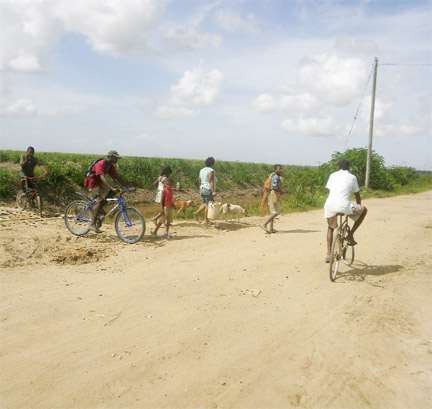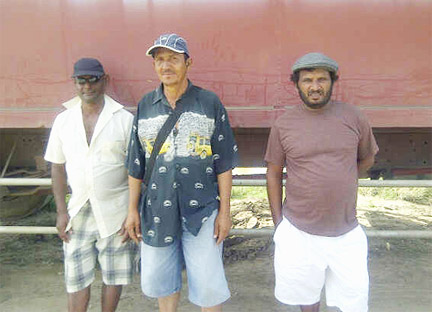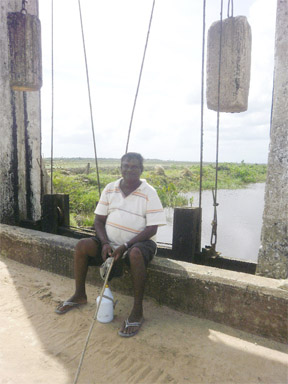After you pass the canefields of Wales and Patentia along the Demerara River you come to the quiet village of Vive-la-Force, which takes its name from a colonial plantation. It is a village that is hardly known by outsiders since it lies down the backdam.
The journey to Vive-la-Force takes the visitor along a clay road that is flanked by bushes and canefields. There is no sign of people as you travel but the lantern poles and street lights alongside the roadway give you some confidence that the journey will not lead to a dead end.

At the end of a bumpy two miles or so car ride, signs of human existence begin to reveal themselves, as men on tractors and trailers pass by and children on bicycles are to be seen. Further into the village the atmosphere is very tranquil as the cool breeze from the Demerara River wafts along the streets.
Vive-la-Force is a community that consists mainly of Indians, residents said, although members of other races also reside in the area. It is one of those communities where electricity, phones, potable water, schools, a health centre and street lights are present to make life comfortable.
There is a primary and a nursery school in the area, but the older children have to go to Patentia Secondary. Residents say that on school days schoolchildren of all ages can be seen riding their bicycles to the Patentia road head where they would take either a bus or car to their various schools.

Ronald Dhanraj was sitting on the koker grazing his cows when we approached him. Dhanraj said he has been living in the area for 46 years and back then there were only about twelve houses. This changed, however, after the village received electricity, since more and more people began to occupy the lands. To date, about 115 houses can be found in and around Vive-la-Force and Dhanraj estimated the population as something below a thousand.
Buses or cars do not run to the village unless they have been specially hired, so those who cannot afford to pay the required fare have to walk the almost three miles road to Patentia for a bus. Dhanraj said this does not apply to him because his son in-law has a car and he uses his vehicle when needed.

Before roads were constructed in the village residents used boats as their mode of transportation, and in the dry weather tractors and trailers. Things have changed since then, he said, because “We gat light, water, phone… we nah even gah land now.” Dhanraj said he used to live on leased land but he paid a small sum of money and received his transport so it is now his.
He also told us that when he was younger he was employed at the Wales Estate. Since he has retired he rears cows and operates a small shop in the area. He now receives a pension from the estate but he still keeps cows as a recreational activity, rather than sitting at home. He told this newspaper, “Rather dan deh home lay down steady and drink beers, you belly start get big. If dis belly grow now you can’t get am back flat. With this hey now [grazing cows] you come down an walk walk an get lil exercise.”

He said he was looking at his animals because in the days when he used to keep sheep: “You does get lil hustle and thing. Dem man does come with boat and thief you sheep. Me does bring dem out bout 12 a clack and carry dem in bout 5 a clack.”
Residents in the area said that they do their shopping from the comfort of their homes because buses and trucks would come in and sell everything that they need, so there is no need to go outside. Because of this, Dhanraj said his business cannot compete because the trucks sell more cheaply than he does.
Eighty per cent of the people in Vive-la-Force work at the Wales Estate while the rest of the population is engaged in cash crop farming, farmer’s cane, or is employed in Georgetown. Next to the Vive-la-Force primary and nursery school there is the health centre, which meets the medical needs of persons in the community. The health centre is not open on most days but when it is people make full use of it, the villagers said.
But as it pertains to recreational activities, Dhanraj noted that they do not have such things expect for a few persons who would play cricket in the area. He said, “People does go out a Wales side but old people a deh home. Now abe get lil current you can deh home and watch you lil tv. Me a fan a news… I does watch all de news cause we a catch all de channels.”

When asked what is special about his village the man responded, “Ordinary man can come and develop you self more than outside deh. You can plant you lil garden or you can catch lil fish. Me bring up me four children them and me nah ask me wife fuh wuk. Me had chiney seine wah ma set a riva, me had cast net wah you can get fish − all dem thing dah a come in. You can do something in hey.”
In making his point he made reference to the price of dry coconuts which are sold by persons in other areas, when he gives people coconuts free. He also said that never mind that the environment outside his village may be better, when one looks at the cost of living it is higher, so in Vive-la-Force he can afford to save a little more. He also said that he is neither rich nor poor, but lives comfortable or “deh lil one way,” as he put it.
Annie Mangal had just finished shopping from one of the trucks that sells in the area, and was heading back to her home when Sunday Stabroek stopped her for a chat. Mangal said that her concerns relate to the deplorable road in the village and the need for activities to keep youths away from drugs. Mangal stated that when the men and young men are finished working in the canefields around midday, there is nothing to do for the rest of the day. She said, “They aint get nothing to do; we need a lil ball field so they can play lil ball fuh even the lil ones dem, and we can watch dem. Dem gah play in de yard and dem a lash ball an bus people window.”

Like the other villagers, Mangal also complained about the hassle in getting transportation in and out of the village. In disgust she said, “You gah fuh walk cause if you hire a car dem want $700, so you either deliver de baby on the road cause the health centre not working every day, only Fridays and Wednesdays…” No doctor is at the location on these two days Mangal said when asked. She also said that there are only churches are in the area, no mosque or mandir.
Dennis Leacock works at the Wales Estate and was walking out of the village when we caught up with him. He told us that he was previously a cane-cutter but is now in charge of the cane-cutting. During the conversation, Leacock challenged the notion that many people have about cane-cutters earning a lot of money. He said that this is not always the case since the amount of money earned depends on the type of cane being cut.
He said that if the cane is light cane-cutters would not make anything much compared to those who cut the good quality cane. He added, “For cane cutter to earn something they have to go over the gunnel [above the punt line] but if is nice cane they only have to load three bundle once is de right quality cane. But SpongeBob [lighter type of cane] you could load from hey till to heaven and you won’t get nothing.”
Leacock and two of his friends introduced us to seventy-four year-old Eustace Phoenix who was sitting in his hammock below his house patching the holes on his cast net. When Sunday Stabroek approached him and asked him his age he replied, “Me a lil boy, me still young.”
Phoenix said that he lives with his wife in their modest home and is a general labourer. Like most people, he used to cut cane in his youth but he has since retired. He told us that a long time ago there was what he called a ‘rubbish road’ in the area which was better than the road they currently have because it did not have big holes.

He said, “Vehicle neva used to come in hey, only estate truck. Abe used to get wata a pan. Long time been far beta than now; it nah been gat no chopping up and war and thing.”
He also jokingly told us, “Long time me bin a bad thief man; dem people used to hide them data from me…” Phoenix had plantains, oranges, golden apple and other fruits and vegetables in his yard. When asked if he sells his produce he said, “Dem thing dah nah do fuh me alone… one one people come dem get couple.”
Further down the road Mandat Singh, who describes himself as the man who contributed the most towards the development of the village, was sitting under a tree. Singh claimed that through his determination the village was able to receive electricity and water and soon he would get the relevant authorities to fix the potholed clay road. Singh said that Vive-la-Force is one village that has attracted the attention of the government, adding that he wants his village to be a model that other villages can look at.
While we were in the area businessman, Ramchand Mangal, who operates a shop and liquor store stopped us to share his concerns. He claimed that the village has many challenges which include poor drainage, a bad road and a lack of recreational activities for youths. Mangal said that the drainage is so bad that at the slightest rainfall the place becomes flooded. He also stated that due to the state of the road persons do not have the encouragement to buy a vehicle to serve their transportation needs because the potholes destroy vehicles.

Living in Vive-la-Force is quite comfortable, residents agreed, but it would be better if they had a good road.





